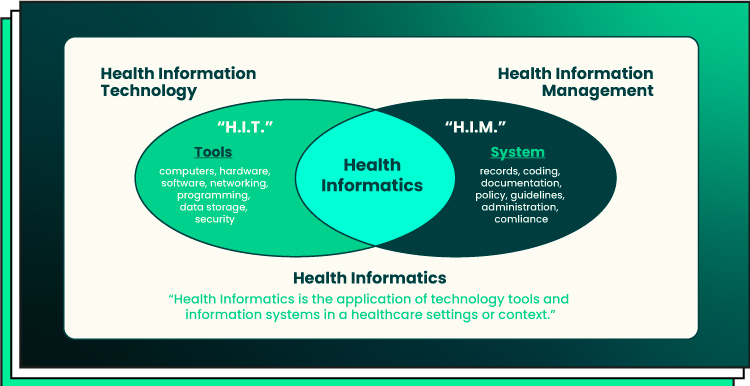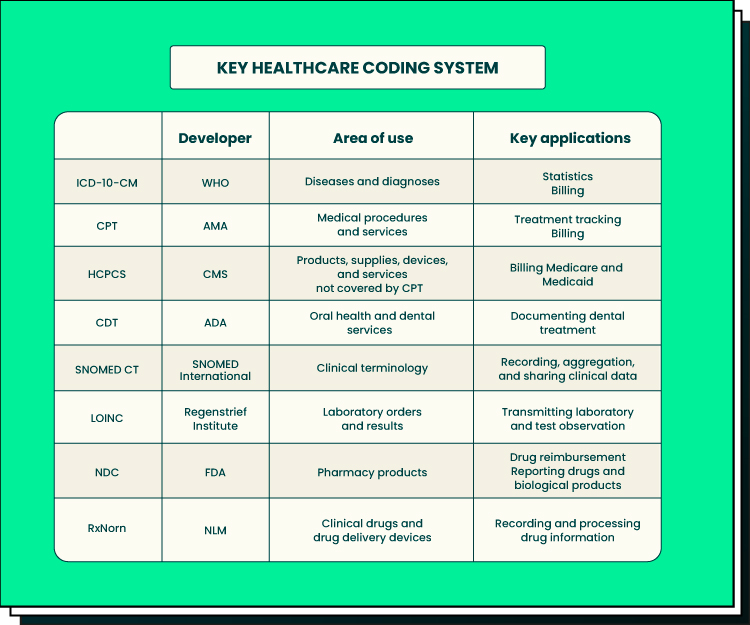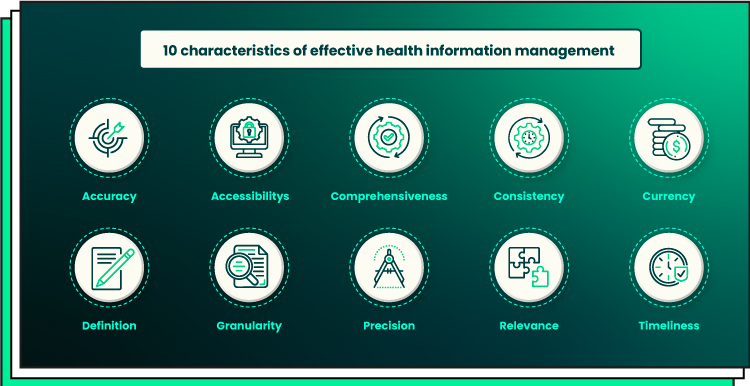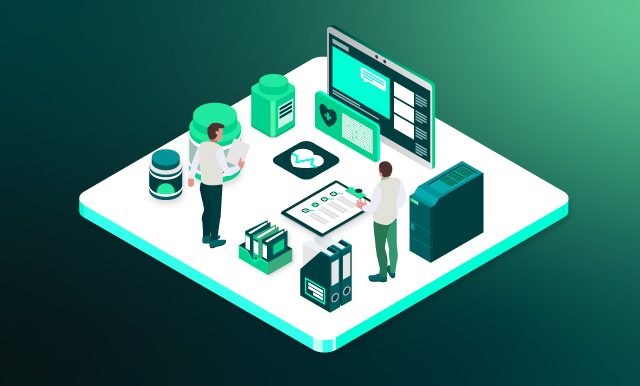The term “Health Information Management (HIM)” stands for itself. It’s applied in the healthcare industry to organize and arrange information management practices. The information managed in health information systems is usually related to patient care, medical history, health status, etc.
In this article, we will dive into the essence of healthcare information management, look back at the history of HIM practices, and define the benefits of implementing HIM at healthcare facilities. Also, we will analyze different HIM system types and help you move to the next steps of digitizing the healthcare experience.
What Is Health Information Management (HIM)?
The purpose of building health information systems is to streamline the process of acquiring, analyzing, and collecting information and improve patient care. The meaning and use of health information management software is briefly explained in the video below:
Health information management has a lot to do with health informatics. This field of science is focused on inventing methods, computational techniques, and novel technologies for collecting, processing, and analyzing clinical documentation. The data can come from various sources like electronic health records (EHR), test results, medical scans, and alike. Health informatics is where medicine meets with computing and software engineering. Health information management is a part of the health informatics concept, playing a vital role in facilitating healthcare services and improving patient outcomes.
Another term related to information management in healthcare is health information technology. It forms the core of health information management and covers the medical information technologies and tools used to enable information management and exchange. Health information management technology allows patients, health services managers, quality monitoring professionals, and other stakeholders to securely share patient information by leveraging verified types of software and hardware. Together with health informatics, health information technology aids professionals in their effort to streamline data management in healthcare.

What do HIM professionals do?
Health information management professionals leverage information management systems and information storage tools, develop health information policies, and identify and address the emerging needs of patients and providers to further facilitate the processes. HIM professionals work with different information types, including clinical, coded, epidemiological, financial, personal, demographic, reference data, and others.
To be more precise, the work of healthcare HIM professionals covers the following areas:
- Collect, validate, and store health information. HIM experts introduce policies and procedures that regulate these processes, which increases the efficiency, quality, security, and effectiveness of health information systems.
- Analyze information and generate insights. Health information managers use the information they collect to drive insights, make predictions with big data in healthcare, create reports, enable analytics, etc. to improve patient care.
- Ensure information accessibility. HIM professionals ensure that health information is spread among healthcare providers and that they can exchange data securely.
- HIM resource management and driving innovation. This involves the management and maintenance of information sources and leveraging innovative tools for data collection across the sources.
- Health information governance and stewardship. A health information manager makes sure that HIM in healthcare is implemented in compliance with rules and laws and that there are no security and confidentiality breaches. Also, they play a vital role in ensuring that health information is leveraged in accordance with ethical norms and organizational policies.
Below, you can see the key healthcare coding systems used by HIM professionals to regulate healthcare information management. The codes help them record, document, and report healthcare information so that other healthcare providers can leverage and interpret it.

HIM History: A Word About the Growth of HIM Standards
The history of healthcare information management can be broken down into 3 phases. Let’s discuss each one separately.
Phase 1: The emergence of AHIMA as a starting point of the HIM existence
AHIMA, which stands for American Health Information Management Association, laid the foundation of modern HIM standards. The association was established in 1928 by a group of medical record experts striving to arrange and standardize the work with clinical records in healthcare institutions and medical facilities. AHIMA librarians aimed to bring more accuracy and order to the work with health information and ensure easy management of medical datasets.
The organization has played a pivotal role in bringing clinical, administrative, and operational aspects of HIM together and ensuring information accuracy and precision.
Phase 2: The establishment of HIMSS and the popularization of industry knowledge
HIMSS (Healthcare Information and Management Systems Society) was founded in 1961 as a nonprofit organization. At that time, it was called a Hospital Management Systems Society and included an independent group of individuals striving to improve the quality of healthcare by using top-notch medical information technologies and management computer systems.
As of now, the HIMSS society consists of around 100,000 members who elaborate on the ways and models to assess information excellence in healthcare.
Phase 3: The growth of HIM education and evolvement of the new medical information technologies
The growth of HIM education and the popularity of the health information management degree have taken this field to a whole new level, bringing thousands of new professionals to the world of healthcare. The organization responsible for setting educational standards for health information management professionals is called CAHIIM (Commission on Accreditation for Health Informatics and Information Management Education). Now, many universities and institutions offer certified programs for associates and bachelors. By 2030, the demand for health information management specialists will grow by 9%, as the Bureau of Labor Statistics reports. This, in turn, will increase the opportunity for students to build a successful career in health information.

Health Information vs Health Data: What’s the Difference?
These two terms are often used interchangeably in the healthcare and medical context. However, those working with information management in healthcare know about the difference between patient health data and information. Heath data means “raw data,” like figures, numbers, or values obtained right from the source. Health information is the data after being processed or the data structured into a meaningful form. We’ll give you an example.
“25 years,” “4 p.m.,” “100/60 blood pressure,” or “Ann Green” are the pieces of raw data obtained from specific sources. After interpreting the data, healthcare professionals will get the following result “25-year-old woman Ann Green had a blood pressure of 100/60 at 4 p.m.” This result will be treated as health information.
10 Characteristics of Effective Healthcare Information Management
For effective health information management, information should be characterized by the following elements:

- Accuracy. Information should be accurate and valid and should contain correct values.
- Accessibility. Healthcare providers should be provided with the legal right to access health information.
- Comprehensiveness. Health information leveraged in a health management information system should be exhaustive for practitioners to have a 360-degree view of the clinical situation of each patient.
- Consistency. The value and meaning of information should be the same across all systems.
- Currency. Healthcare providers should keep health information up to date.
- Definition. The providers should use standard terminology and medical codes to make sure that the data is interpreted in the right way.
- Granularity. The information should be broken down into details whenever needed, each having its meaningful value.
- Precision. The value of information as well as its format should be compatible with the information systems for healthcare management being used.
- Relevance. A hospital information system should contain only relevant health information.
- Timeliness. Health information should be documented timely, ensuring that no vital details are missed or ignored.
6 Types of Information Management Systems in Healthcare
A hospital information system is designed to store, maintain, manage, and structure health information in electronic form. Some of the systems are owned by private entities and can be accessed only by the patients or healthcare providers working in that organization. Others, like patient portals, are accessible to the public.
Depending on the purpose, information systems for healthcare management can be categorized in the following way:
Patient portals
Patient portals are used by patients to access their personal health information and data, check their appointment history, view test results, lab results, X rays, and medical scans, refill their requests, schedule new appointments, and more. Such portals may also contain useful information on patient health, tips on how to improve healthcare outcomes, the opportunity to get in touch with a physician via the platform, etc.
EHR or Electronic Health Records
Electronic Health Records contain information about patient health, test results, history of treatment, history of surgeries, etc. A health management information system of this kind helps healthcare providers exchange information and keep it in order for other specialists to access it easily. Electronic medical records gradually replace paper-based medical records and are aimed to digitize the experience of both healthcare providers and patients.
Remote patient monitoring
The technological concept laying at the core of remote patient monitoring is called telemedicine. By leveraging medical sensors and special software, physicians can remotely control the state of the patient’s health and monitor critical health metrics (such as blood pressure, glucose level, etc.). They can export the data in real time and share it with colleagues to facilitate the treatment.
Master patient index
A master patient index is designed to connect multiple patient records across systems. With its help, healthcare HIM technicians ensure data integrity and consistency. By using the master patient index, the healthcare providers index all patient records registered in their organization. This also helps prevent data duplicates and gives medical providers a more comprehensive picture of the patient’s state.
Clinical decision support
This health information system helps practitioners facilitate the decision-making process and improve patient outcomes accordingly. With the help of this software type, healthcare providers can analyze health information from different systems to forecast medical events and diagnose accurately.
Practice management software
This health information system is designed to help practitioners manage and automate their daily operations and tasks. They use practice management software to manage scheduling, patient appointments, billing, etc. Such software is frequently used by healthcare enterprises like hospitals or small practice facilities. Practice management software saves a lot of time and ensures quick access to all the information essential for daily practice.
Some other types of health information systems include radiology information management systems (RISs), medical billing software, pharmacy management systems, and laboratory information management systems (LISs).
Benefits of Implementing Information Systems for Healthcare Management
By using a health record information system, your organization gets the following benefits:
- Detecting trends and tendencies. We can talk about big data here. By analyzing and interpreting data with AI-powered medical apps, healthcare providers can detect trends and tendencies in the population and their state of health. By analyzing trends, they forecast health situations and take preventative measures to timely eliminate health risks.
- Increasing efficiency. Using a health information management system can lead to significant cost savings. You can cut maintenance costs by shifting from paper-based information management to digital format. Also, you will dramatically reduce the number of people involved in information processing and recording since most of the processes and tasks will be automated.
- Promoting collaboration. Patient health information documented on paper cannot be shared with multiple practitioners simultaneously. The spread of this information will take time and effort, not to mention the cases when some pieces of health records are lost or damaged. In contrast to this, information systems for healthcare management allow for easy information access by health care professionals who can discuss each case, share tips, and come up with the best formula for patient treatment. This also facilitates advancements in healthcare.
- Insights and analytics. The more information an expert has at hand, the more insightful their work is. Information management systems enable the team to collect and store health information as well as draw conclusions from it and make patient information work for their own benefit.
These benefits help increase patient satisfaction with your healthcare services and improve their outcomes. As for the healthcare providers, they save their time and effort by automating information management and centralizing data in a single system.
How Can Forbytes Help with HIM System Implementation?
In this paper, we outlined the basics of the healthcare HIM to give you a fundamental understanding of HIM software, the benefits of HIM in healthcare, and the best practices of HIM implementation. To undergo digital transformation in your medical facility or healthcare organization, you will need the assistance of niche experts. The knowledge we share will help you choose skilled HIM technicians and consultants who possess the right competencies and are able to address your organization’s particular needs.
Whether you need help with building a solution from scratch or configuring an off-the-shelf system, Forbytes can help. We can plan out and complete such tasks as data encryption, data backup, data migration, database preparation, compliance management, software integration, and more. With the help of multifactor authentication, access control, and other security measures, we will make sure that the software is safely integrated and leveraged in your business infrastructure.
Contact us to discover our solution to your specific healthcare management needs.








